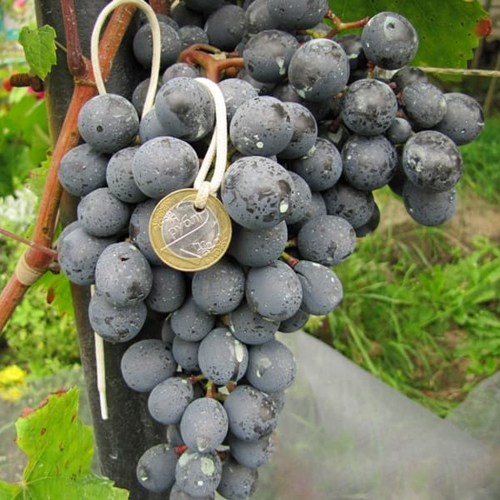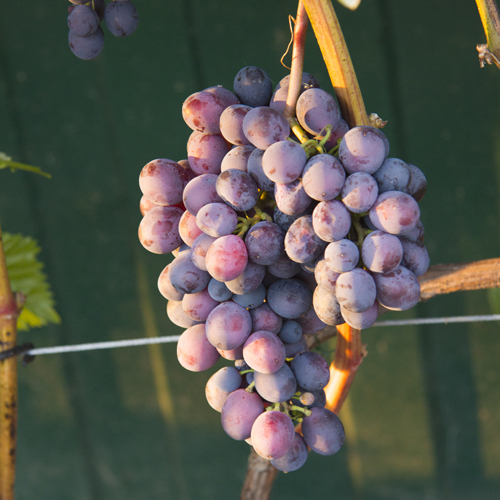Grape variety Agat Donskoy
Agate Donskoy is a widespread variety of dark-colored table grapes, which is especially popular in the northern regions, due to its unpretentiousness, increased frost resistance and a rather early ripening period.
The variety was obtained in the 80s of the last century at the All-Russian Research Institute of Viticulture and Winemaking. The famous scientists Ya.I. Potapenko, whose name is currently the institute, I.A. Kostrikin, L.A. Maistrenko, A.S. Skripnikov, S.I. Agapova. When crossing, a rather complex combination was used, during which initially hybridization was carried out with the participation of the varieties Zarya Severa and Dolores, and then the resulting form was fertilized with pollen of the Russian Early. As a result of such a complex scheme, the DNA of the novelty has incorporated a wide range of genes from various types of grapes, which determine its high plasticity and adaptability to a variety of growing conditions.

Initially, the hybrid was named Vityaz, but later the official name was changed to the current one. Since then, both names have been encountered, but they mean the same variety. The promising form was transferred to the state variety trial in 1987, and in 1992 it was successfully completed, after which Agat Donskoy was included in the State Register of Breeding Achievements of the Russian Federation, being officially recommended for planting in the North Caucasian and Ural regions. Due to the adaptability of the variety to growing in harsh climatic conditions, amateur winegrowers have spread it in a large number of areas of the Non-Black Earth Zone, as well as in the south of Siberia, where it has perfectly acclimatized, delighting its owners with rich, generous southern crops.
Agrobiological characteristics
Vigorous grape bushes, annual shoots reach 2-3 meters in length. The crown of the young shoot has a weak cobweb pubescence. Leaves are medium in size and large, dark green, heart-shaped, mostly five-lobed with a slight degree of dissection and curving upward edges. The upper side of the leaf is finely bubbly, the lower side is covered with bristly pubescence of low intensity. The lateral notches are barely outlined, and often completely absent. Petiole notches are found open, slit-like, or closed, with almost no lumen. The petiole is somewhat shorter than the main vein. The denticles along the edges of the leaf are medium-sized, triangular or saw-shaped, have a wide base, curved sides and slightly pointed, and sometimes blunt apices. The flowers of Agatha Donskoy are bisexual, and therefore they do not need additional pollination, and the berries are not prone to peas. Despite the considerable length of the one-year growth, it ripens very well, by 70-90%. A ripe vine changes its color from green to brown. In this case, the nodes are colored more brightly than the internodes.
The bunches of the variety are above average in size, conical, of moderate density, sometimes loose, weighing 400-600 grams. The combs are long, graceful, light green in color. The grapes are large, round, dark blue or red-violet in color, 22-25 mm in diameter, weighing 4-6 grams. The surface of the grapes is covered with a dense layer of a protective wax coating. The uniformity of the berries is high, which is why the brushes have a very attractive, neat appearance. Also, due to the not too dense arrangement of the grapes, they do not damage each other and do not deform. Their pulp is fleshy, rather juicy with a simple, but at the same time pleasant taste, without specificity in the aftertaste and aroma. The sugar content of the juice is not the highest - 13-15 g / 100 ml, the titratable acidity is 6-7 g / l. The peel is quite thick, but it does not differ in its coarse structure, and therefore it is eaten. The seeds are large, 1−2 in each berry, noticeable when eaten.At the same time, the tasting characteristics of Agat Donskoy are quite decent, and are estimated at 7.7 points, which is even slightly higher than the standard for which Shasla White was accepted.

There can be several directions for using the harvested crop. In addition to direct consumption, delicious homemade preparations for the winter are made from these grapes: compotes, jams, preserves. Some lovers try to make wine out of it, but this drink is of unsatisfactory quality, with a low alcohol content, inexpressive taste and very unstable in storage. It is also not suitable for commercial cultivation on farms, because recently, many varieties have appeared that significantly surpass our hero in aesthetic and gastronomic parameters, moreover, earlier ripe ones. They lose to him only in resistance to unfavorable factors of cultivation, but buyers in the market care little about this fact, and therefore they choose grapes of a more attractive appearance. The keeping quality of Agatha Donskoy is not bad due to the thick skin of the berries, and therefore the collected clusters can be stored and consumed for a very long time.
According to the duration of the growing season, it belongs to the early-middle varieties. If we count from the beginning of budding in the spring, then usually 115-120 days pass before the maturation of the first brushes. During this time, the plants require a moderate amount of heat, which allows them to feel great even in such, by no means a wine-growing region, like the Moscow region. Here, according to the testimony of many amateurs, grapes have time to gain their usual condition, and are quite suitable for consumption. Frost resistance increased to -26 ° C also contributes to the promotion of culture to the north, however, in areas with the most severe climate, these indicators will still not be enough, and even our hero will need shelter.
The yield of Agatha Donskoy is one of his greatest strengths. Its high performance is facilitated by an excellent percentage of fruitful shoots (75-80%) and a large number of clusters on productive vines (1.3-1.5). In combination with the relative large-fruited variety, these features guarantee excellent yields, especially on bushes cultivated with a good level of agricultural technology and formed with a large supply of perennial wood. In such cases, the mass of bunches collected from one plant can reach 40-50 kg. At the same time, there are also obvious overloads of grapes with a harvest, which make themselves felt by weak growth of shoots, prolongation of the growing season and a deterioration in the quality of the harvest. The most neglected cases, especially with their annual recurrence, can end very badly for the bushes themselves. This fact requires the grower to carefully ration the load of shoots and crops through pruning and subsequent green operations.

On the vine, grapes can continue to hang for a long time after ripening only in dry, warm weather. In damp conditions, as well as in the case of sudden changes in soil moisture, provoked by torrential rains that replaced the dry season, the berries crack massively and require quick consumption or processing. Wasps are not particularly interested in thick-skinned berries, so this variety can be considered naturally protected from them. However, as soon as the "crackle" of grapes appears, annoying insects rush en masse to the damaged fruit.
Agrotechnical features
It should be recognized that despite the official admission of Agat Donskoy to cultivation in the North Caucasus region, this variety is still more suitable for northern regions that are not spoiled by heat.In traditional wine-growing regions it is difficult for her to compete with high-quality varieties and hybrids, but in the middle zone of the country, and even more so in the Urals and Siberia, this grape will be very useful.
With sufficient heat supply, it is placed both on the plains and on the slopes, but in the case of the risk of incomplete maturation, it is worth considering the choice of the landing site more carefully. The highest level of SAT can be achieved by planting a vineyard in the upper part of the southern slopes, and in the conditions of a personal plot, the same effect can be achieved in the so-called. "Wall culture", when the bushes grow on the southern side of various buildings, which serve as protection from cold winds. But the northern slopes, lowlands of valleys and gullies are not suitable for the variety, even in the absence of a lack of heat. A similar limitation applies to places with a high level of groundwater, excessively wet and swampy soils.
Cuttings of this grape variety root very well, which greatly facilitates its propagation even for inexperienced winegrowers. At the same time, planting of Agatha Donskoy on its own roots can be carried out only in regions free from phylloxera root. If there is no confidence in the absence of root aphids, then in order to avoid fatal consequences, it is worth using grafted phylloxera-resistant seedlings. The feeding area for vigorous bushes is allocated sufficient - at least 4.5-5 sq. meters.
The need to cover the vine, and with it the method of plant formation, depends on the minimum winter temperatures in a particular area. The best option for the variety would be powerful high-standard non-covering ways of keeping bushes, and the ideal one would be to place them on arches and arbors. However, they are possible only where the thermometer does not overcome the critical mark of -26 ° C. In most regions of cultivation of this grape, its frost resistance will not be enough, and cultivation can be carried out only with the use of covering schemes and their characteristic squat formations in the form of an inclined cordon or a multi-arm fan.
To regulate the load, the bushes in the spring are loaded with 35-45 eyes, with a pruning length of 5-8 buds. With the beginning of the growing season, weak and sterile shoots break off, keeping only fruitful ones, in number 22-26 per plant. Before flowering, inflorescences are also thinned out, leaving no more than two brushes on strong shoots, and on vines of medium strength - one at a time.
The variety is quite resistant to fungal diseases, and can be cultivated with minimal chemical treatments against downy mildew and gray rot. Certain attention is required only to control the development of Agat Donskoy oidium, however, his outbreaks are easily eliminated with the help of modern contact and systemic drugs. For preventive purposes, it is advisable to carry out such agrotechnical methods as removing grape leaves in the fruit zone, which, in addition to worsening conditions for the development of pathogens, will be useful for insolation of bunches during ripening, and therefore better accumulation of sugars in them.








